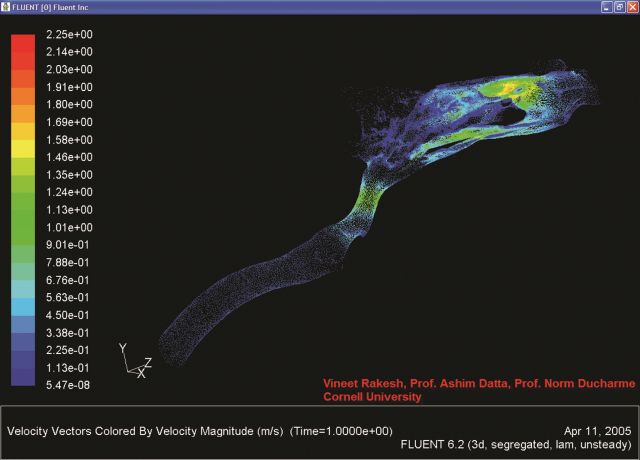 Remesh Technology Drastically Reduces File Preparation
Remesh Technology Drastically Reduces File Preparation- Case presented by the College of Veterinary Medicine and the Biological and Environmental Engineering department, Cornell University, UK.
Imagine the ability to prepare scanned human or animal geometry for Computational Fluid Dynamics (CFD) analysis in a few days. Cornell University, Ithaca, NY, discovered that the Mimics Innovation Suite's Remesh technology can help them reduce file preparation time from several weeks to a day or two! The days of moving and reshaping triangle after triangle manually in pre-processing software are gone forever. Remesh technology enables the user to generate a surface mesh quickly. The resulting mesh is directly transformable into a volume mesh for CFD.
Cornell University Hospital for Animals
The grouping functionality allows for clear visualization and easy treatment of problem areas
The grouping functionality allows for clear visualization and easy treatment of problem areas
Opened in 1996, Cornell University Hospital for Animals is one of the finest veterinary teaching hospitals in North America. Within the field of sports medicine, they specialize in performing stress tests on horses exercising on a high-speed treadmill at their Equine Performance Testing Clinic. Here they identify respiratory obstruction in performance horses, using finite element analysis tools such as airway pressure determination and airflow measurement. Normally, it would take several weeks to prepare a scan of a horse's airway system for modeling these types of analysis. Intrinsic to human and animal geometry are sharp or thin-walled areas which require a very fine surface mesh to enable the generation of a volume mesh. Without a good volume mesh, CFD software will fail to return accurate analysis results. The research team thus was in need of high-quality remeshing software to reach the required high level of triangulation. In the past, the Cornell University team would improve surface mesh quality by moving and reshaping triangle after triangle at critical areas. This is a very time-consuming, labor-intensive process.
A High-Quality Surface Mesh in a Few Days
Intrigued by the possibility of using the Mimics Innovation Suite's to automate this mesh optimization process, Cornell University sent a benchmark to Materialise. They made a CT scans of a race horse's nasal cavity, nasopharynx and larynx, and converted these into an STL model. The STL model required extensive mesh optimization before it could be used for CFD, but it took Materialise's Remesh team only a few days to return the file with a mesh directly transformable in a high-quality volume mesh for CFD.
"WE WERE REALLY AMAZED HOW FAST THE FILE WAS OPTIMIZED! THE FILE RAN SMOOTHLY THROUGH THE CFD SOFTWARE. WHEN THEY SHOWED US HOW EASILY YOU CAN REFINE THE CRITICAL AREAS AUTOMATICALLY, ALL OUR DOUBTS DISAPPEARED. WE'VE PURCHASED OUR OWN REMESH MODULE AND ARE CONFIDENT THAT WE WILL BE ABLE TO SAVE A LOT OF TIME, WHILE AT SAME TIME MAINTAINING THE ACCURACY AND RELIABILITY OF THE CDF RESULTS." VINEET RAKESH, BIOLOGICAL AND ENVIRONMENTAL ENGINEERING DEPARTMENT, CORNELL UNIVERSITY.
 a. Rough triangulation (because the scan wasn't detailed enough) b. Thin wall – with current triangulation it's impossible to fit good tetrahedrons c. Highly skewed triangles, not meeting the quality requirements
a. Rough triangulation (because the scan wasn't detailed enough) b. Thin wall – with current triangulation it's impossible to fit good tetrahedrons c. Highly skewed triangles, not meeting the quality requirements
a. Rough triangulation (because the scan wasn't detailed enough) b. Thin wall – with current triangulation it's impossible to fit good tetrahedrons c. Highly skewed triangles, not meeting the quality requirements
The nasal cavity model output produced by the image processing software contained many sharp edges and thin walls. In those areas, the triangulation was not fine enough to enable CFD software to fit tetrahedrons inside. Overall, the triangulation didn't meet the general requirements imposed by the CFD software. Using the Mimics Innovation Suite's wide range of highly advanced, automated tools, they could easily optimize the surface mesh both globally and locally.
After a global remeshing operation on the entire file, the majority of the triangles conformed to the required triangle shape quality. Next, the software allowed for automatic selection and inspection of all sharp geometry.
The grouping functionality enables the user to view and further remesh specific critical areas. Grouping is a very powerful tool: it makes only the triangles around a certain problem area (defined f.i. by triangle quality or geometry sharpness) visible. The user can iterate over each problem area individually or treat them all simultaneously. There is no need to spend days rotating and zooming in and out, looking for possible problem areas, some of which may be hidden inside the geometry. In this case, a few of the hardest problem areas were deleted and refilled. Then, local remeshing (refining) and smoothing operations were performed on the remaining groups until the mesh was suited for CFD.
www.materialise.com
























































































